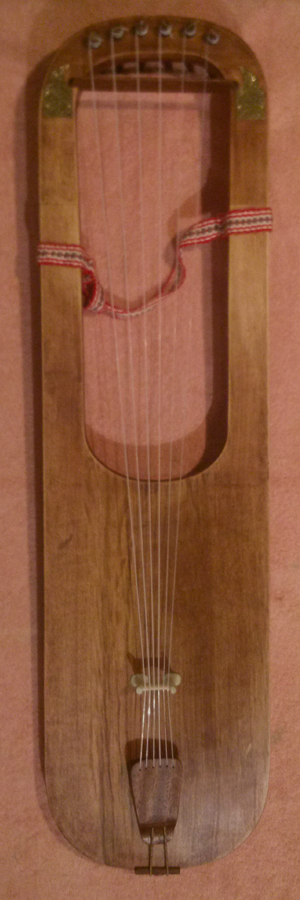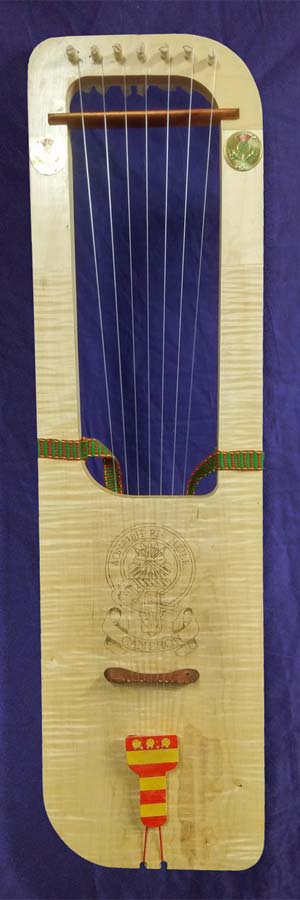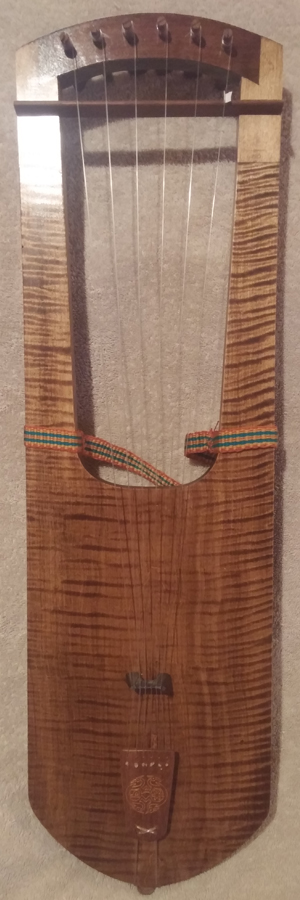More specifically, our common offerings are Anglo Saxon Lyres and Germanic Rotes. The epic sagas of the early Germanic, Viking and Anglo-Saxon tribes would not have been so widely spread if it weren't for skilled Skalds and Skops travelling the lands enthralling audiences with heroic tales accompanied by skilled manipulation of these beautiful 6 stringed instruments. Used to set mood, to influence emotion, to convey action and motion, these weren't solo performance instruments, these were used to layer on top of the voice of a skilled storyteller as he wove a fabric of heroic deeds, great joys and terrible tragedies, spreading the history as they provided entertainment to the nobles and commoners alike. But this was not just the instrument of skilled performers; it was the fireside instrument played in intimate gatherings of friends, while on voyages or in the lonely nights between battles. It is a meditative instrument that can help bring calm to the spirit and joy to the halls and chambers of any manor, or with a bit of skill and a lot of heart, can bring men to tears, war-rage, rouse them from their bedchamber or send them to peaceful slumber. Be the teller of your own epic story.
We base our instruments on archaeological evidence, historical art and written documentation, but we do not replicate these instruments. Instead, we choose to take what we know from these sources and our own experience, mix in the imagination of the customer, occasionally add in a drop of technological magic, and create what a lyre builder of this era would have created, a unique piece for his client. So drop us a message or give us a call. We promise, we won't charge to answer your questions.

Sutton Hoo style
The parallel sided, round ended lyre was typical of the instruments found and depicted in evidence of the British Isles and throughout the Northland. These are the biggest lyres we have found fragments of, and as a performance instrument because of their soundboard area and depth they have the potential to be the loudest. Finds from Sutton Hoo, Bergh Apton, Morning Thorpe and Prittlewell, among others, provide ample evidence for this style lyre. And while it is larger and a bit less elegant in form, this lyre style has more in common than different with all the rest.

From the Alemannic people of middle and southern Europe came a different form of lyre. Narrower, shallower and more delicate in form, these instruments narrowed at the soundboard, had more intricate and sharp pegbars, and a more tapered playing window. The Trossingen find, the only existing complete lyre, was discovered in a burial chamber near the property of the Weiss Harmonica company when construction workers were excavating for a new car park. Intricately decorated with an incising technique known as kolrosing, this was the instrument of a Prince. The Oberflacht find provides a similar style instrument, a bit less ornate but following the same form.
Another Germanic lyre, the Oberflacht find produced evidence of this and one more instrument. One was destroyed when the alcohol it was being preserved in was consumed by Russian soldiers during the liberation of Germany in WWII, the other exists as just fragments. The two instruments differed in that one had it's peg-yoke set farther between the arms, and the other, like the Trossingen find, was more square-headed. Like the Trossingen, the narrow soundboard lends itself to lighter thinner construction, offsetting the effect of the smaller soundboard area.
This lyre is based on a single find, a stone carving on Gotland. Most graphic evidence contains some reference to scale, but this instruments was alone, as a central solitary motif. We have no idea of size, little idea of number of strings or really details of any type. Because building an instrument to the information we have is not only possible but produces a fine lyre, we decided not to try to transpose or interpret anything that we could find in the carving. As an extra, there is an ongoing debate over lyre tailpieces, with only one possible find located to date (the Teerns bone tailpiece). Many hypothesize that leather or gut was used as a tailpiece, and others think that in many cases there likely was not tailpiece. We designed this instrument without a tailpiece, and found it to be a fine sounding, stable instrument.
 Two
different stone high cross carvings on Iona provide the
evidence for this distinctive instrument. Due to
it's asymmetrical shape, it has a larger soundboard area
and soundbox volume than a comparable sized Sutton Hoo
style instrument and the visual cues from the carvings
show it to be a large lyre. Although a practice of
taking artistic renderings at face value is sometimes
frowned upon in a field such as this, in the absence of
any indication that the historic rendering was
fundamentally incorrect, we decided to work with the
information we had and fill in the blanks. This
large 7 string instrument has a bridge based on the High
Mountain Pasture Cave on Skye - possibly more than a
thousand years separate the two objects, but technology
moved slowly during these early centuries and thus it was
not improbable that the bridge design remained in service
for a millennium or more. It is an extremely
powerful instrument as lyres go, suited for the voice,
status and ego of any medieval Scotsman (or Scotswoman).
Two
different stone high cross carvings on Iona provide the
evidence for this distinctive instrument. Due to
it's asymmetrical shape, it has a larger soundboard area
and soundbox volume than a comparable sized Sutton Hoo
style instrument and the visual cues from the carvings
show it to be a large lyre. Although a practice of
taking artistic renderings at face value is sometimes
frowned upon in a field such as this, in the absence of
any indication that the historic rendering was
fundamentally incorrect, we decided to work with the
information we had and fill in the blanks. This
large 7 string instrument has a bridge based on the High
Mountain Pasture Cave on Skye - possibly more than a
thousand years separate the two objects, but technology
moved slowly during these early centuries and thus it was
not improbable that the bridge design remained in service
for a millennium or more. It is an extremely
powerful instrument as lyres go, suited for the voice,
status and ego of any medieval Scotsman (or Scotswoman).Of the two lyres found in the Oberflacht grave excavation, the grave 84 type was narrow and long. The second set of fragments indicated a shorter, wider instrument. This was thin, with a pegbar joined to the arms with wooden pegs and a crossbar nut mortised into the body. This was by all indications a very plain instrument, that of a common man. While the construction was in many ways similar to the Trossingen, it was lacking ornament or decoration. This lyre, because of the larger relative soundboard area, was chosen by Ranier Thurau and Benjamin Bagby as the inspiration for Ben's current performance instrument. It has a relatively wide string spacing, and is a fairly powerful lyre in actual size, and one of the loudest and strongest when built to the larger "Uberflacht" configuration


